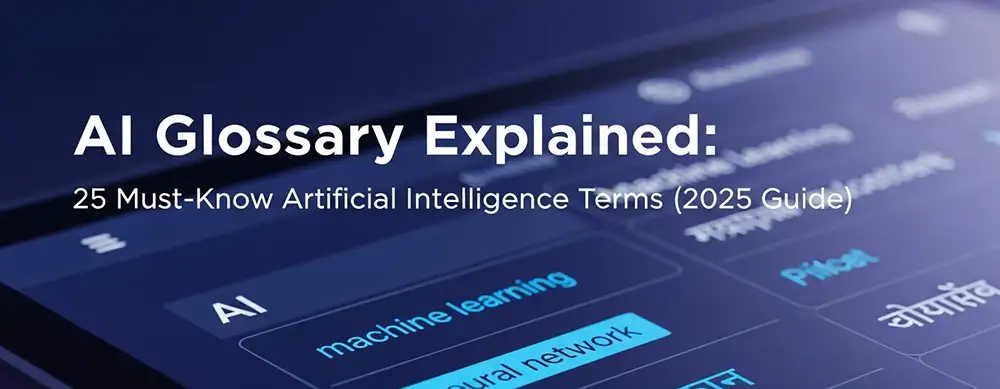
🤖 AI Glossary Explained: 25 Must-Know Artificial Intelligence Terms (2025 Guide)
🔍 Why You Need to Understand AI Terms
Artificial Intelligence (AI) is transforming everything from healthcare to finance. But with so many technical buzzwords, it’s easy to get lost. Here’s a simple glossary of essential AI terms you need to know to stay informed and ahead in 2025.
📘 Top AI Terms and Their Meaning (In Plain English)
1. Artificial Intelligence (AI)
A field of computer science that enables machines to simulate human intelligence—like learning, reasoning, and problem-solving.
2. Machine Learning (ML)
A subset of AI where computers learn from data without being explicitly programmed. Example: Netflix recommending shows based on your watch history.
3. Deep Learning
A type of machine learning that uses neural networks with many layers. Commonly used in facial recognition, voice assistants, and autonomous driving.
4. Neural Network
A structure inspired by the human brain, made of nodes ("neurons"). It processes input and adjusts itself during training to make better predictions.
5. Natural Language Processing (NLP)
AI that understands, interprets, and generates human language. Used in chatbots, translation apps, and voice recognition (like Siri, ChatGPT).
6. Computer Vision
A field of AI that allows machines to "see" and interpret visual data like images and videos. Used in self-driving cars, facial recognition, and medical imaging.
7. Supervised Learning
A machine learning method where models are trained on labeled data. Example: Teaching a model to identify cats by showing it 10,000 labeled cat photos.
8. Unsupervised Learning
AI learns patterns in unlabeled data. It’s used for clustering, recommendation engines, and data compression.
9. Reinforcement Learning
An AI technique where the model learns by trial and error through rewards and penalties. Used in robotics and games like AlphaGo.
10. Large Language Model (LLM)
An AI model trained on huge amounts of text to understand and generate human language. Example: ChatGPT, Claude, Gemini.
11. Prompt Engineering
The practice of crafting input prompts that get the best responses from LLMs. It's a key skill in getting accurate AI outputs.
12. Generative AI
AI that can create new content like text, images, audio, or video. Tools like Midjourney, DALL·E, and Runway are popular examples.
13. Transformer
A powerful deep learning architecture used in most modern language models (like GPT, BERT). It allows AI to understand the context of words.
14. Tokenization
The process of breaking text into smaller pieces (tokens) so AI models can process them. Example: "I love AI" → [I, love, AI].
15. Bias in AI
When an AI model gives unfair or inaccurate results due to biased training data. For example, facial recognition systems that perform poorly on dark skin tones.
16. Overfitting
When an AI model learns too much from training data and performs poorly on new, unseen data.
17. Underfitting
When an AI model is too simple to learn useful patterns and performs poorly on both training and new data.
18. Fine-tuning
The process of taking a pre-trained model and training it further on a smaller, task-specific dataset (e.g., a medical chatbot trained on patient data).
19. AI Ethics
The study of moral implications of AI. It includes fairness, privacy, safety, transparency, and accountability.
20. Explainable AI (XAI)
AI systems that can justify or explain their decisions, making them more transparent and trustworthy.
21. API (Application Programming Interface)
A way for developers to connect and use AI models through code—like calling GPT-4 via the OpenAI API.
22. Dataset
A collection of data used to train or test AI models. Quality and diversity of datasets matter greatly in AI performance.
23. Inference
The phase when a trained AI model is used to make predictions on new data. For example, when ChatGPT responds to your question.
24. Training
The phase where an AI model learns from data using algorithms, adjusting internal parameters to improve accuracy.
25. Model Parameters
The internal settings (like weights) that an AI adjusts during training to learn from data. Modern models have billions of parameters!
🧠 Final Thoughts
Understanding AI isn’t just for developers anymore. Whether you're a student, entrepreneur, or curious mind, these 25 terms form the foundation of AI literacy in 2025 and beyond.